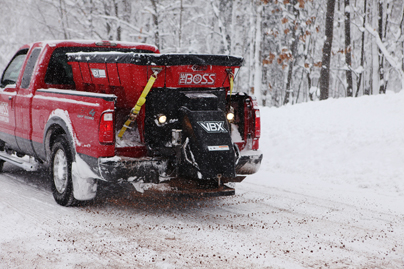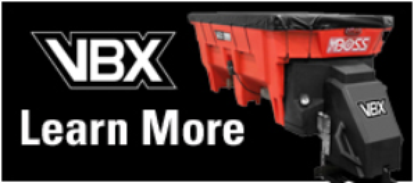
When it comes to ice management, there are many spreading applications available for a contractor to choose from. There are many different features and spreading materials that can be used, which can make choosing the right equipment a little difficult. Whether you are responsible for deicing your own personal driveway or if you are a commercial snow and ice management professional, we’ve created this guide to help sort out what you’ll need to consider before purchasing deicing equipment.
1. What type of job are you doing?
The type of work you need to accomplish with your equipment is going to impact what kind of system you’re going to want. If you are responsible for maintaining large parking lots or have numerous accounts to service, you will want to consider a hopper spreader or a larger capacity tailgate spreader. These units allow you to load more material into it at one time, which means less driving back and forth to refill the unit. If you’re primarily maintaining driveways or servicing smaller accounts you’ll want to consider a smaller to mid-sized capacity tailgate spreader. The capacity of these units is sufficient for smaller jobs and you will have the benefit of not having to empty excessive amounts of material following the deicing event.
2. Truck GWAR
The available axle weight capacity of your vehicle is going to ultimately be the determinant of what size spreader you can put on your truck and how much spreading material you can safely add. It is important to note that you cannot exceed the overall Gross Weight Axle Rating or the Rear Axle Weight Rating of your vehicle, so you must take that into consideration before purchasing a spreader. Most spreader manufacturers will include the weight of the spreader when it is filled and unfilled in the specs. The bigger the spreader, the heavier it is. Ultimately, it is your responsibility to know how much your vehicle can handle and refer back to the spreader manufacturer for weights to pick the appropriate equipment.
3. Materials you’ll be spreading
You’ll also need to consider what kind of material you plan on spreading. In general, dry, free flowing material is recommended for spreader use. A hopper spreader is better equipped to handle bulky material as well as material that may be a little more moist or prone to bridging. If you are looking to spread bulk rock salt or anything with larger chunks, a larger tailgate spreader may also be equipped to handle it. Finer spreading materials are going to be more suitable for the smaller capacity tailgate spreaders, but you’re not necessarily limited to them. Some large spreaders may be able to handle finer material, however, sometimes if you are using a material that is too fine in a large spreader, you may find that the material won’t stay in the unit. To combat this problem, BOSS offers a material saver system, standard on the TGS 300, which utilizes a brush to help keep fine material in until you’re ready to use it. Ultimately, check with the manufacturer and see what materials they suggest using with their equipment.
4. Material the spreader is made from
The material that your spreader is made out of is very important. Since you’ll be working with highly corrosive materials, it is vital that you choose a spreader that is made from a corrosion resistant material. Both stainless steel and polyethylene are good options, however there is a weight difference between the two. Low density polyethylene is going to be lighter than steel, giving you the option to get a bigger spreader, increase the number of vehicle applications you can mount the spreader on and increase the amount of material you can load into your equipment.
5. Ease of Attachment
If you are considering a tailgate spreader, you’ll need to look at the attachment system. Having a system that is easy to use and fast to hook up is desirable as you head out to battle the storm. BOSS offers an optional RT3 attachment system for some of our tailgate spreaders that allow you to roll your spreader up to the truck and simply angle it back and slide it in to attach it. This eliminates the need for two people to hook it up and the wheels can flip up and out of the way after attachment.
6. Auger vs. Pintle Feed System
On a hopper spreader you’ll have to choose between an auger or pintle chain feed system. The auger system has fewer moving parts and is better for handling dry, free flowing material. The auger will essentially pull the salt and sand material towards the discharge chute. The even pulling of the material by the auger allows the auger feed system to have a more “even” flow of material, and as a result, the spread pattern coming off the spreader tends to be more even than it does with a pintle chain system. The auger is also a little bit lower maintenance, as it has few moving parts. The pintle system utilizes a flat pintle chain which acts as a conveyor that feeds the material from the hopper to the discharge chute and spinner assembly. A pintle chain system can carry larger amounts of material to the discharge chute. It can also better handle moist material and bigger pieces like the sizes found in pea gravel or bulk salt.
7. Motor
The motor is the next big item that should be considered when comparing deicing equipment. Again, when you deal with deicing, you are dealing with corrosive materials. Make sure your motor is up to the test and look for one made out of stainless steel. If you’re leaning towards hopper spreaders, you’ll also need to consider whether you want a motor that runs on gas or electricity from the truck. By choosing an electric motor, you’ll spend less money on gas and it is a much quieter system, so if you have residential accounts, you won’t wake anyone up with a noisy system.
8. Spinner
The spinner, just like the other pieces of equipment, needs to be constructed out of a corrosion resistant material. A spinner made out of poly or stainless steel will do the trick, but you’ll also want to consider a material that is flexible and won’t crack in the cold. The spinners on BOSS spreaders are made from polyurethane. This material is durable and won’t crack from the cold and, unlike steel which can be permanently bent or dinged, if you should back into something and hit it, the poly material is flexible so all it’s going to do is bend back and forth. It won’t hurt other parts of the spreader like the motor shaft.
9. Controller
The controller is the primary means of communication between you and the spreader so you’ll want to take it into careful consideration. You want a controller that is going to be easy to understand and to use. BOSS offers a controller for our hopper spreaders that features backlit buttons for nighttime use and an LCD display screen. And because this world is full of different cultures and languages, this screen is based heavily upon pictures not words, so everyone can use it no matter what their first language is. For example, if the top screen is open, the controller will communicate that through a picture displaying an open box.
10. Lighting
If you’re going with a hopper spreader, you’ll need to consider the lighting system. Any lighting system needs to be up for the test of the elements, so it should be cold resistant and easy to control. The lighting system is especially important when spreading at night. Because of the hoppers size, at night you won’t be able to see if your equipment is spreading properly without a lighting system. It will also be useful for extra lighting when backing up and can be utilized as work lights when you’re outside of the vehicle. Having a lighting system also adds a measure of safety as it increases your visibility to others who may be in the area.
11. Top Screen
You should be looking for a spreader that comes with a top screen. A top screen is going to help filter the materials you put in to your spreader. It will catch any huge chunks or material that might have bridged together. It will also catch any large rocks or sticks that sometimes appear in bulk materials. If you are going with a tailgate spreader, look for a top screen that includes a bag splitter to easily open bags and save time. BOSS has also added a safety measure to our top screens on our hopper spreaders, mainly that the spreader will not run unless the screen is down. This guards against any accidental operation that could result in injury if you are inspecting something inside the spreader.
12. Cover
The cover you pick will be based purely upon personal preference. A tarp cover and a hard cover each have their advantages. A hard cover is going to be durable and quicker to close, however, a tarp cover is going to be more flexible. If you add a lot of material into your spreader, a tarp cover is going to be able to mold over the material and still have the ability to close off the top of your spreader.
13. Storage
If you want a larger spreader, you’ll have to consider where you’re going to store all the spreading material you’ll need. The material should be stored in a covered, waterproof storage facility. If salt or spreading materials get wet, they start to bridge together and become difficult to spread or could even damage your equipment.
14. Alternate Applications
There are many different spreader applications that might fit your needs, such as skid steer applications, dump truck, all the way down to ATVs. Remember to do some research and make sure you’re choosing an application that is safe for the vehicle you’re putting it on.
And don’t forget about walk behind spreaders for sidewalk use and skid steer applications. Remember to refer to the manufacturer for specific information about their equipment and their suggestions.







